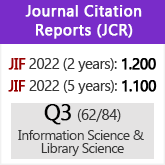Book reviews in Spanish scholarly journals in the Social Sciences and Humanities: analysis of production between 2007 and 2009
DOI:
https://doi.org/10.3989/redc.2011.4.841Keywords:
Bibliometric analysis, Social Sciences, Humanities, reviews, scientific output, scholarly journals, Spain, booksAbstract
The goal of this work is to analyse the production of reviews published between 2007 and 2009 in the scholarly journals in the Social Sciences and Humanities contained in the ISOC database. Different aspects were analysed: time pattern, journals, authorship and author affiliation. Also examined were the books reviewed, by publication type, language, authorship, publisher and time lag between the books’ publication and the appearance of the reviews. The results concerning the reviews show a constant reduction in their production and a large number concentrated in the humanities. Authors are mostly Spaniards and university lecturers, who publish alone and have a very low level of productivity. There is also a high level of endogamy among those authors who are members of editorial boards. The results concerning the reviewed books reveal that few titles were reviewed more than once, there are a large number of monographs, mostly in Spanish, and there is a long time lag between a book’s publication and the appearance of its review.
Downloads
References
Alcaraz-Ariza, M. A. (2008). Las reseñas de libros médicos escritos en español: un estudio sociopragmático de las expresiones de alabanza. Ibérica, 16, 37-58.
Clark, K. A., y Mai, B. A. (2000). Locating book reviews in agriculture and the life sciences. Science & Technology Libraries, vol. 18 (4), 3-27.
Chen, C. C., y Wright, A. M. (1974). Current status of biomedical book reviewing: Part I. Key biomedical reviewing journals with quantitative significance. Bulletin of the Medical Library Association, 62 (2), p. 105-112.
Chen, C. C. (1974a). Current status of biomedical book reviewing: Part II. Time lag in biomedical book reviewing. Bulletin of the Medical Library Association, 62 (2), 113-119.
Chen, C. C. (1974b). Current status of biomedical book reviewing: Part III. Duplication patterns in biomedical book reviewing. Bulletin of the Medical Library Association, 62 (3), p. 296-301. PMid:4471577 PMCid:198797
Chen, C. C. (1974c). Current status of biomedical book reviewing: Part IV. Major American and British book publishers. Bulletin of the Medical Library Association, 62 (3), 302-308. PMid:4466508 PMCid:198798
Chen, C. C. (1974d). Current status of biomedical book reviewing: Part V. Most frequently reviewed biomedical books in 1970. Bulletin of the Medical Library Association, 62 (3), 309-313. PMid:4466509 PMCid:198799
Diodato, V. (1988). Impact and scholarliness in arts and humanities book reviews: a citation analysis. Challenges to an information society. Proceedings of the 47 th ASIS annual meeting, p. 217-220. White Plains, NY: Knowledge Industry Publications.
Grant, M. J., y Booth, A. (2009). A typology of reviews: an analysis of 14 review types and associated methodologies. Health Information and Libraries Journal, 26, 91-108.
Greene, R. J., y Spornick, C. D. (1995). Favorable and unfavorable book reviews: A quantitative study. The Journal of Academic Librarianship, Vol. 21, n.º 6, 449-453.
Hartley, J. (2005). Book reviewing in the BJET: a survey of BJET’s referees’ and writers’ views. British Journal Journal of Educational Technology, vol. 36 n.º 5, 897-905.
Lee, A. D.; Green, B. N.; Johnson, C. D., y Nyquist, J. (2010). How to write a scholarly book review for publication in a peer-reviewed journal: a review of the literature. The Journal of Chiropractic Education, vol. 24, n.º 1, 57-69.
Lindholm-Romantschuk, Y. (1998). Scholarly book reviewing in the social sciences and humanities: The fl ow of ideas within and among disciplines. Wesport: Greenwood Press. Martin, Lynne, M. (1986). The evaluation of Biomedical Book Reviews by Academic Health Sciences Librarians. Bulletin of the Medical Library Association, 74, 2, 157-160.
Morton, P. Y. (1983). Medical book reviewing. Bulletin of Medical Library Association, vol. 71 (2), 202-206.
Murphy, M., y Renman, S. U. (1987). The reviewing of management literature. Library Quarterly, vol. 57, 32-60. http://dx.doi.org/10.1086/601825
Nicolaisen, J. (2002) The scholarliness of published peer reviews: a bibliometric study of book reviews in selected social science fields. Research Evaluation, vol. 11, n.º 3, 129-140.
Nicolaisen, J., y Frandsen, T. F. (2007). The handicap principle: a new perspective for library and information science research. Information Research, 12 (4). Disponible en http://InformationR.net/ir/12-4/colis/colis23.html [consulta: 21 de enero de 2011].
Palmer Bermúdez, N. (2005). Los elementos fundamentales de una reseña. Puerto Rico: Neyssa Palmer Bermúdez. Disponible en: www.1.uprh.edu/cruzmigu/ESPA_LEFDUR.pdf [consulta: 21 de enero de 2011].
Sabosik, P. A. (1988). Scholarly Publishing and the role of Choice in the post publication review process. Book Research Quarterly, 10-18. Shaban, R. (2006). A guide to writing book reviews. Journal of Emergency Primary Healt Care, vol. 4, n.º 3, 4.
Wheeler Carlo, P., y Natowitz, A. (1995). Choice book reviews in American history, geography, and area studies: An analysis for 1988-1993. Library Acquisitions: Practice & Theory, vol. 19, n.º 2, 153-165.
Downloads
Published
How to Cite
Issue
Section
License
Copyright (c) 2011 Consejo Superior de Investigaciones Científicas (CSIC)

This work is licensed under a Creative Commons Attribution 4.0 International License.
© CSIC. Manuscripts published in both the printed and online versions of this Journal are the property of Consejo Superior de Investigaciones Científicas, and quoting this source is a requirement for any partial or full reproduction.All contents of this electronic edition, except where otherwise noted, are distributed under a “Creative Commons Attribution 4.0 International” (CC BY 4.0) License. You may read here the basic information and the legal text of the license. The indication of the CC BY 4.0 License must be expressly stated in this way when necessary.
Self-archiving in repositories, personal webpages or similar, of any version other than the published by the Editor, is not allowed.

















